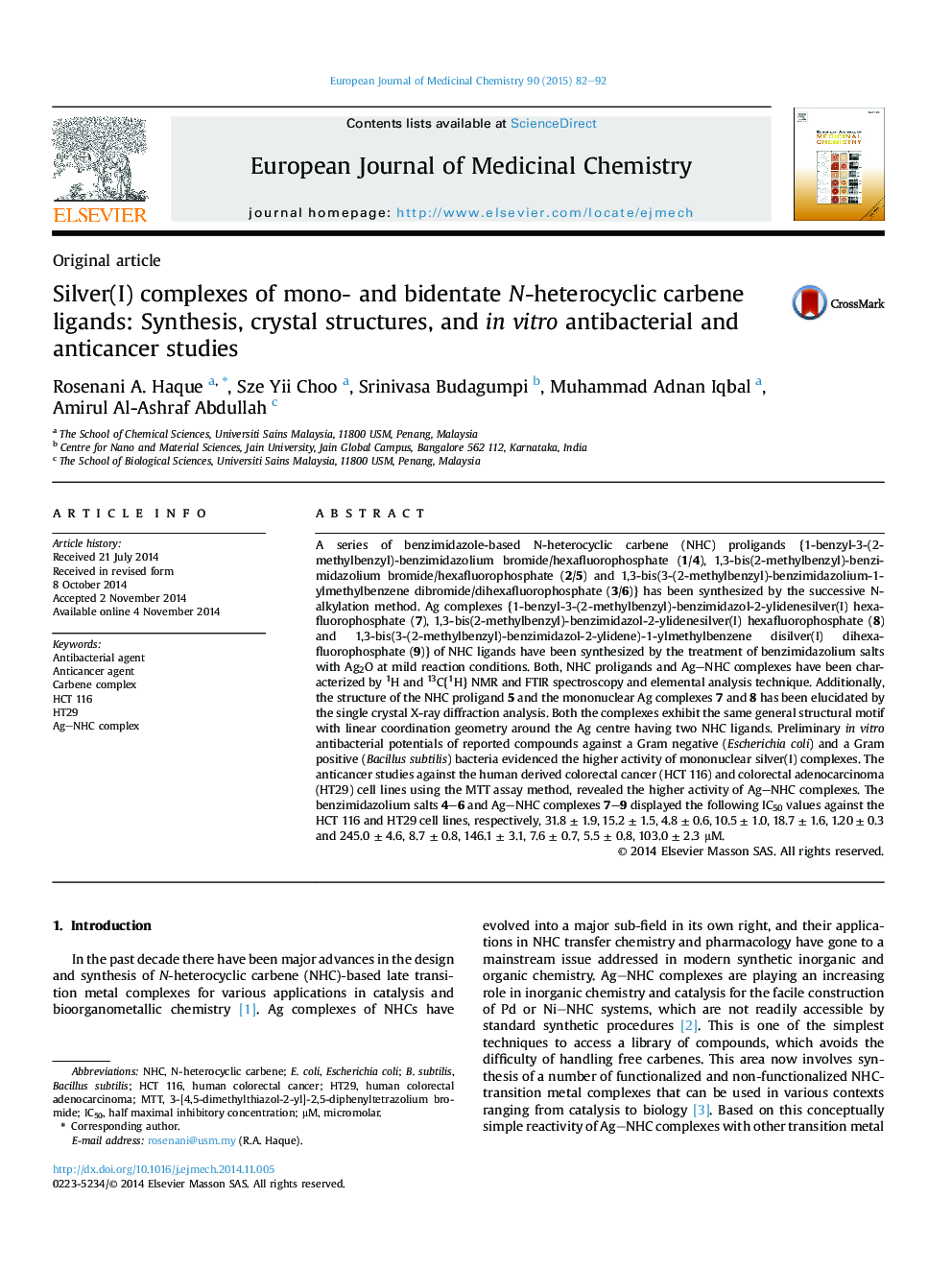| Article ID | Journal | Published Year | Pages | File Type |
|---|---|---|---|---|
| 1395479 | European Journal of Medicinal Chemistry | 2015 | 11 Pages |
•Benzimidazolium salts and their Ag–NHC complexes are reported.•Structure of a salt and two complexes have been studied by single crystal XRD.•Antimicrobial studies revealed the higher activity of mononuclear Ag complexes.•Ag complexes found more active than salts in anticancer studies.
A series of benzimidazole-based N-heterocyclic carbene (NHC) proligands {1-benzyl-3-(2-methylbenzyl)-benzimidazolium bromide/hexafluorophosphate (1/4), 1,3-bis(2-methylbenzyl)-benzimidazolium bromide/hexafluorophosphate (2/5) and 1,3-bis(3-(2-methylbenzyl)-benzimidazolium-1-ylmethylbenzene dibromide/dihexafluorophosphate (3/6)} has been synthesized by the successive N-alkylation method. Ag complexes {1-benzyl-3-(2-methylbenzyl)-benzimidazol-2-ylidenesilver(I) hexafluorophosphate (7), 1,3-bis(2-methylbenzyl)-benzimidazol-2-ylidenesilver(I) hexafluorophosphate (8) and 1,3-bis(3-(2-methylbenzyl)-benzimidazol-2-ylidene)-1-ylmethylbenzene disilver(I) dihexafluorophosphate (9)} of NHC ligands have been synthesized by the treatment of benzimidazolium salts with Ag2O at mild reaction conditions. Both, NHC proligands and Ag–NHC complexes have been characterized by 1H and 13C{1H} NMR and FTIR spectroscopy and elemental analysis technique. Additionally, the structure of the NHC proligand 5 and the mononuclear Ag complexes 7 and 8 has been elucidated by the single crystal X-ray diffraction analysis. Both the complexes exhibit the same general structural motif with linear coordination geometry around the Ag centre having two NHC ligands. Preliminary in vitro antibacterial potentials of reported compounds against a Gram negative (Escherichia coli) and a Gram positive (Bacillus subtilis) bacteria evidenced the higher activity of mononuclear silver(I) complexes. The anticancer studies against the human derived colorectal cancer (HCT 116) and colorectal adenocarcinoma (HT29) cell lines using the MTT assay method, revealed the higher activity of Ag–NHC complexes. The benzimidazolium salts 4–6 and Ag–NHC complexes 7–9 displayed the following IC50 values against the HCT 116 and HT29 cell lines, respectively, 31.8 ± 1.9, 15.2 ± 1.5, 4.8 ± 0.6, 10.5 ± 1.0, 18.7 ± 1.6, 1.20 ± 0.3 and 245.0 ± 4.6, 8.7 ± 0.8, 146.1 ± 3.1, 7.6 ± 0.7, 5.5 ± 0.8, 103.0 ± 2.3 μM.
Graphical abstractA series of benzimidazolium salts and their Ag complexes have been reported. Three of the reported compounds have been structurally studied using single crystal X-ray diffraction studies. Preliminary antibacterial and anticancer studies evidenced that Ag complexes are more potential than their corresponding salts.Figure optionsDownload full-size imageDownload as PowerPoint slide
